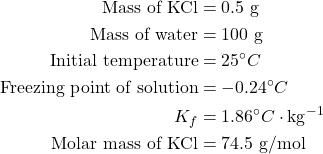What is called Abnormal Molecular Mass?
The molecular mass of a solute present in a solution calculated with the help of colligative properties is different from its calculate molecular mass is called Abnormal molecular mass or Observed Molecular Mass.
- It is denoted by Mo.
- For an ideal solution, Mo = Mc (Where Mc is calculated molecular mass)
- In case of dissociating molecules, Mo < Mc ( Ex. Solution of NaCl in H2O)
- In case of associating molecules, Mo > Mc (Ex. Solution of CH3COOH in water)
- This phenomenon takes place when solution is non-ideal that means solution is not dilute or solutes undergo dissociation or association.
Vant’s Hoff Factor in Abnormal Molecular Mass
What is Van’s Hoff Factor ?
The ratio of the experimental value of the colligative properties to the calculated value of the colligative properties is called Van’t Hoff Factor. It is denoted by ‘i’.
The formula of Van’t Hoff Factor can be written as: General formula: ![]()
For dissociation: ![]()
As we know that, Colligative Properties is inversely proportional to molecular mass hence ![]()
Calculation of Van’t Hoff Factor in case of Dissociation:![]() In case of strong electrolytic solute:
In case of strong electrolytic solute:
i = No. of moles after dissociation of solute and as α = 1
For example, In case of NaCl, i = 2 As NaCl → Na+ + Cl–
In case of K2SO4, i = 3 As K2SO4 → 2K+ + SO42- .
In case of weak electrolytes: Suppose a molecule of a weak electrolyte is allowed to dissolve in a suitable solvent, it produces ‘n’ ions and its degree of dissociation be ‘α’. Then Vant’s Hoff factor can be calculated in the following way:
A → n1B + n2C + n3D + —— or n1 + n2 + n3 + —- = n
| At initial | 1 | 0 |
| At equilibrium | 1 – α | nα |
Since ![]()
And ![]()
![]() As we know that
As we know that ![]() Hence,
Hence, ![]()
Some important numericals regarding Van’s Hoff equation:
Question No. 1. The freezing point depression of 0.1 molal solution of acetic acid in benzene is 0.256 K. Kf for benzene is 5.12 K kg mol -1. What conclusion can you draw about the molecular of acetic acid in benzene ?
Solution: Here, we are given that m = 0.1mol kg-1and Kf = 5.12 K kg mol-1.
∴ Theoretical calculated value of ΔTf will be ΔTf = Kf × m = 5.12 K kg mol-1 × 0.1mol kg-1
= 0.512 K. As observed (experimental) value of ΔTf = 0.256 K (Given)
Thus, the observed value is half of the theoratical value. This data suggests that acetic acid id doubly associated in benzene. Since the observed value depends upon the number of particles actually present in the solution.
Question No. 2. 0.5 g KCl was dissolved in 100 g water and the solution originally at 20oC, froze at – 0.24oC. Calculate the percentage ionization of salt. Kf per 100 g of water = 1.86oC.
Solution:
Given Data:

Step 1: Calculate Freezing Point Depression
![]()
Since water freezes at
![Rendered by QuickLaTeX.com \(0^\circ C\), \[ \Delta T_f = 0 - (-0.24) = 0.24^\circ C \] Step 2: Use Freezing Point Depression Formula \[ \Delta T_f = i \cdot K_f \cdot m \] where: \( i \) = Van't Hoff factor \( K_f = 1.86^\circ C \cdot \text{kg}^{-1} \) \( m \) = Molality Step 3: Calculate Molality (m) Molality is given by: \[ m = \frac{\text{moles of solute}}{\text{kg of solvent}} \] Moles of KCl: \[ \frac{0.5}{74.5} = 0.00671 \text{ moles} \] Mass of water in kg: \[ \frac{100}{1000} = 0.1 \text{ kg} \] \[ m = \frac{0.00671}{0.1} = 0.0671 \text{ mol/kg} \] Step 4: \[ i = \frac{\Delta T_f}{K_f \cdot m} \] \[ i = \frac{0.24}{1.86 \times 0.0671} \] \[ i = \frac{0.24}{0.1248} = 1.92 \] Step 5: Calculate Percentage Ionization For KCl dissociation: \[ KCl \rightarrow K^+ + Cl^- \] Using the Van't Hoff factor equation: \[ i = 1 + \alpha (n - 1) \] Since KCl dissociates into 2 ions, \( n = 2 \): \[ 1.92 = 1 + \alpha (2 - 1) \] \[ 1.92 = 1 + \alpha \] \[ \alpha = 1.92 - 1 = 0.92 \] \[ \alpha \times 100 = 92\%](https://learneasily8.com/wp-content/ql-cache/quicklatex.com-caf0615f5a2bb99c24d3edbde8053e25_l3.png)
\]
Percentage Ionization of KCl = 92%
Van’t Hoff Factors in case of Association
When solute is completely associate in a solution, Van’t Hoff Factor can be calculated by the formula as:
![]()
Let n simple molecules of the solute A associate to form the associated molecule An. Hence, nA ⇌ An Now we shall proceed with the following data.
| At initial | 1 | 0 |
| At equil. | 1 – α | α/n |
Where ‘α’ is the degree of association and ![]() Now
Now ![]() or
or ![]() and
and ![]()
Modified Expression of Colligative Properties for any type of solution
- For lowering of vapour pressure
 Where XA is the mole fraction of solute.
Where XA is the mole fraction of solute. - For Osmotic pressure:

- For Elevation in boiling point:

- For Depression in freezing point:

